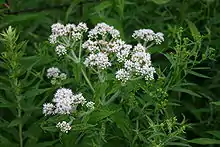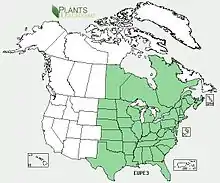Eupatorium perfoliatum
Eupatorium perfoliatum, known as common boneset or just boneset, is a North American perennial plant in the aster family. It is a common native to the Eastern United States and Canada, widespread from Nova Scotia to Florida, west as far as Texas, Nebraska, the Dakotas, and Manitoba.[3][4] It is also called agueweed, feverwort, or sweating-plant. It was introduced to American colonists by natives who used the plant for breaking fevers by means of heavy sweating. It is nearly always found in low, wet areas.
| Eupatorium perfoliatum | |
|---|---|
 | |
| Scientific classification | |
| Kingdom: | Plantae |
| Clade: | Tracheophytes |
| Clade: | Angiosperms |
| Clade: | Eudicots |
| Clade: | Asterids |
| Order: | Asterales |
| Family: | Asteraceae |
| Genus: | Eupatorium |
| Species: | E. perfoliatum |
| Binomial name | |
| Eupatorium perfoliatum | |
 | |
| Synonyms[2] | |
|
Synonymy
| |
Description

Eupatorium perfoliatum grows up to 100 cm (39 inches) tall, with leaves that clasp the stems. The plant produces dense clusters of tiny white flower heads held above the foliage.
Eupatorium perfoliatum can form hybrids with other species of the genus Eupatorium, for example Eupatorium serotinum.[3]
Phytochemistry and safety
E. perfoliatum leaves and roots contain mixed phytochemicals, including polysaccharides (containing xylose and glucuronic acid), tannins, volatile oil, sesquiterpene lactones, sterols, triterpenes, alkaloids, and various flavonoids, such as quercetin, kaempferol, and caffeic acid derivatives.[5][6] E. perfoliatum and several of its related species are listed on the Poisonous Plants Database of the US Food and Drug Administration,[7] with E. perfoliatum described as an "unapproved homeopathic medicine" with unknown safety by the US National Library of Medicine.[5][8]
Holistic health companies marketing fraudulent supplement products that contained E. perforliatum with claims of benefit against COVID-19 were warned by the US Food and Drug Administration in 2020 about making illegal health claims and scamming consumers from their money.[9]
Traditional medicine
Eupatorium perfoliatum (also called boneset) was used in traditional medicine by Native Americans who applied extracts for fever and common colds.[5][6] Possible effects of E. perfoliatum for these uses remain undefined by adequate scientific research, and are unconfirmed by high-quality clinical research.[5][6] If consumed in large amounts, its tea made from leaves may cause diarrhea.[5]
Butterflies
Eupatorium perfoliatum is a specific butterfly food and habitat plant. It provides nectar for butterflies in the adult life cycle stage, particularly the white M hairstreak and the bronze copper butterfly.
References
- "Eupatorium perfoliatum". NatureServe Explorer. NatureServe. Retrieved 2010-09-12.
- "Eupatorium perfoliatum L.". The Global Compositae Checklist (GCC) – via The Plant List.
- Siripun, Kunsiri Chaw; Schilling, Edward E. (2006). "Eupatorium perfoliatum". In Flora of North America Editorial Committee (ed.). Flora of North America North of Mexico (FNA). 21. New York and Oxford – via eFloras.org, Missouri Botanical Garden, St. Louis, MO & Harvard University Herbaria, Cambridge, MA.
- "Eupatorium perfoliatum". County-level distribution map from the North American Plant Atlas (NAPA). Biota of North America Program (BONAP). 2014.
- "Boneset (Eupatorium perfoliatum L.) Uses, Benefits and Dosage". Drugs.com. 1 February 2019. Retrieved 4 March 2019.
- Hensel, Andreas; Maas, Mareike; Sendker, Jandirk; Lechtenberg, Matthias; Petereit, Frank; Deters, Alexandra; Schmidt, Thomas; Stark, Timo (2011). "Eupatorium perfoliatum L.: Phytochemistry, traditional use and current applications". Journal of Ethnopharmacology. 138 (3): 641–651. doi:10.1016/j.jep.2011.10.002. PMID 22004891.
- "Flavonol-3-glucosides in 8 Eupatorium species; In: FDA Poisonous Plant Database". US Food and Drug Administration. 2019. Retrieved 4 March 2019.
- "Eupatorium perfoliatum L." DailyMed, National Library of Medicine, US National Institutes of Health. 2019. Retrieved 4 March 2019.
- "Fraudulent Coronavirus Disease 2019 (COVID-19) Products". US Food and Drug Administration. 7 April 2020. Retrieved 8 April 2020.
External links
| Wikiversity has bloom time data for Eupatorium perfoliatum on the Bloom Clock |
